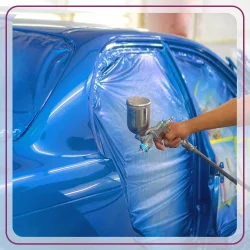They have an oil content between 55-75% and are usually produced based on vegetable fatty acids such as soy, sunflower, etc. These resins dry in a longer time and are soluble in aliphatics.

They have an oil content between 55-75% and are usually produced based on vegetable fatty acids such as soy, sunflower, etc. These resins dry in a longer time and are soluble in aliphatics.
Resistance to atmospheric conditions and yellowing
gloss
Adhesion and lack of brittleness
Good writing ability
Production of glossy building paints
Production of decorative paints
Production of stainless paints
Coating on wood and metal
Low flexibility and high hardness



This resin has properties between Lank Oil and Short Oil.
Its oil percentage is 40 to 60 percent
It dissolves in a mixture of aromatic and aliphatic solvents.
Semi-industrial applications in making oil-based anti-rust
Industrial application in the manufacture of car repair paint
This type of resin is based on non-drying oils and has mostly industrial applications. It is used in making instant nitrocellulose paints and furnace paints. Among the characteristics of this resin, the following can be mentioned:




Paint driers such as cobalt octoate, calcium octoate, and zirconium accelerate the drying process of paint and coatings. These catalysts increase oxidation and polymerization reactions, resulting in faster drying times and improved film properties. Accurate dosage and use of these driers is essential to avoid possible problems with the paint layer.
Cobalt drier is a surface drier and strong oxidizing agent used in the paint and ink industry. It is usually combined with auxiliary skeptics.
Excessive use can cause the surface to wrinkle and the film to become brittle. Adequate dose control is essential for balancing. Because excessive drying of the surface may prevent deep drying of the layer. Cobalt octoate acts as a moisture barrier and has minimal sensitivity to atmospheric moisture.
It increases the speed of polymerization, the hardness and gloss of the paint layer, and at the same time it reduces the brittleness. It also accelerates the catalytic reaction of methyl ethyl ketone peroxide (MEK) for the polymerization of unsaturated polyester resins.
Calcium is widely used as an auxiliary drier in the paint industry. While calcium octoate may not have strong drying properties by itself. But it plays an important role in increasing the effectiveness of secondary dryers such as lead and zirconium. In particular, calcium driers are used as wetting and pigment dispersing agents and help to improve the hardness and gloss of the paint layer. In addition, the presence of calcium significantly reduces the risk of "loss of dryness" in the system and prevents the absorption of pigments into the primary dryer.
Lead octave is a secondary drier through the dryer that increases flexibility. In applications where drying at low temperatures (below 10 degrees Celsius) is required. The most important is the dryer. However, it should not be used due to the tendency to cause wrinkles in aluminum-based paints, as well as in steam and vapor-resistant paints. If there is sulfur in the polluted air. Lead dryers. Lead sulfide produces black color, which leads to darkening and reducing the glossiness of the resulting film. In addition; This dryer is toxic because of lead. Therefore, the best alternative for this product is the C60 dryer, which offers a safer alternative.




Zirconium octoate, which acts as a deep and highly effective auxiliary drier. It is the most well-known alternative to lead-based desiccants. When used in combination with cobalt drier in white colors. It ensures the preservation of the color of the film and prevents its yellowing. This composition also protects the film from the effects of weathering. Unlike lead-based dryers. Zirconium octoate does not produce sulphide in atmospheres contaminated with sulfur and eliminates the formation of black spots on the film. Compared to lead-based driers, zirconium octoate-dried films exhibit greater flexibility, shorter drying time, and less hardness. However, in lower temperatures and humid conditions. This process may be reversed.


Unsaturated polyesters are synthetic copolymers that have applications as fibers, plastics, composites, and coatings. Depending on the choice of monomers, initiators, curing agents, additives and modifiers used, it is possible to produce different types of these types of products that have a wide range of chemical and mechanical properties.


Tehran, Farahzadi Blvd., Sepehr St., No. 18, Unit 2
Phone: 02188562573